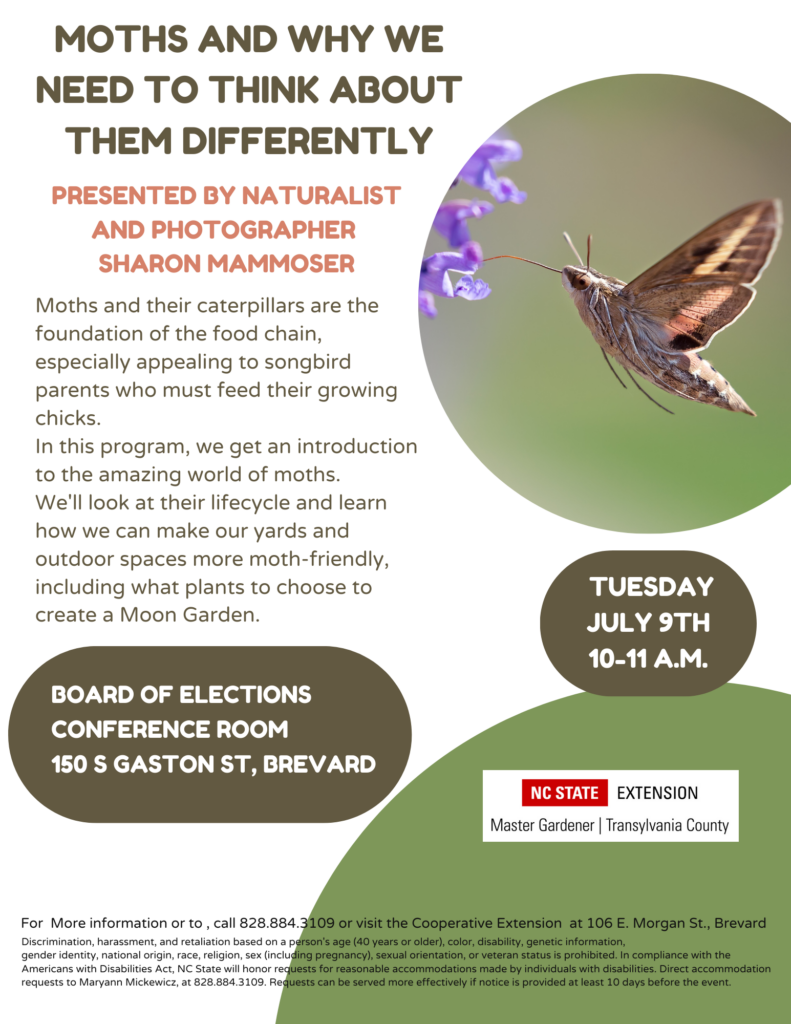Master Gardener Program for July – Moth Gardening With Sharon Mammoser
go.ncsu.edu/readext?1009552
en Español / em Português
El inglés es el idioma de control de esta página. En la medida en que haya algún conflicto entre la traducción al inglés y la traducción, el inglés prevalece.
Al hacer clic en el enlace de traducción se activa un servicio de traducción gratuito para convertir la página al español. Al igual que con cualquier traducción por Internet, la conversión no es sensible al contexto y puede que no traduzca el texto en su significado original. NC State Extension no garantiza la exactitud del texto traducido. Por favor, tenga en cuenta que algunas aplicaciones y/o servicios pueden no funcionar como se espera cuando se traducen.
Português
Inglês é o idioma de controle desta página. Na medida que haja algum conflito entre o texto original em Inglês e a tradução, o Inglês prevalece.
Ao clicar no link de tradução, um serviço gratuito de tradução será ativado para converter a página para o Português. Como em qualquer tradução pela internet, a conversão não é sensivel ao contexto e pode não ocorrer a tradução para o significado orginal. O serviço de Extensão da Carolina do Norte (NC State Extension) não garante a exatidão do texto traduzido. Por favor, observe que algumas funções ou serviços podem não funcionar como esperado após a tradução.
English
English is the controlling language of this page. To the extent there is any conflict between the English text and the translation, English controls.
Clicking on the translation link activates a free translation service to convert the page to Spanish. As with any Internet translation, the conversion is not context-sensitive and may not translate the text to its original meaning. NC State Extension does not guarantee the accuracy of the translated text. Please note that some applications and/or services may not function as expected when translated.
Collapse ▲When many people think about moths, they probably don’t consider them beautiful, very diverse, or worthy of protection. But guess what? Moths outnumber butterflies TEN to one! Worldwide there are more than 160,000 species of moths and about 17,500 of butterflies. Moths and their caterpillars are the foundation of the food chain, especially appealing to songbird parents who must feed their growing chicks. The diversity is shocking, as are the colors, shapes, and adaptations. There are moths with fake eyes, moths with perfect camouflage hiding secret colors, moths that mimic other insects, moths with long tails meant to outsmart bats, moths that sleep in flowers, moths with long proboscises that can reach deep into the nectary of flowers, and moths with antennae so perfect you’d swear they were feathers. There are yellow and pink moths, delicate green moths, and moths with intricate designs that look hand-painted.
In this program, we get an introduction to the amazing world of moths, including a chance to see and learn about some of our more amazing local moths. We’ll look at their lifecycle and adaptations, along with some host and nectar plants that will attract them to your yards. We’ll also learn about their important place in the food web, and how we can make our yards and outdoor spaces more moth-friendly, including what plants to choose to create a Moon Garden.
 MOTHS AND WHY WE NEED TO THINK ABOUT THEM DIFFERENTLY
MOTHS AND WHY WE NEED TO THINK ABOUT THEM DIFFERENTLY
PRESENTED BY NATURALIST AND PHOTOGRAPHER SHARON MAMMOSER
TUESDAY JULY 9TH 10-11 Α.Μ.
BOARD OF ELECTIONS CONFERENCE ROOM
150 S GASTON ST, BREVARD
Moths and their caterpillars are the foundation of the food chain, especially appealing to songbird parents who must feed their growing chicks.
In this program, we get an introduction to the amazing world of moths. We’ll look at their lifecycle and learn how we can make our yards and outdoor spaces more moth-friendly, including what plants to choose to create a Moon Garden.




